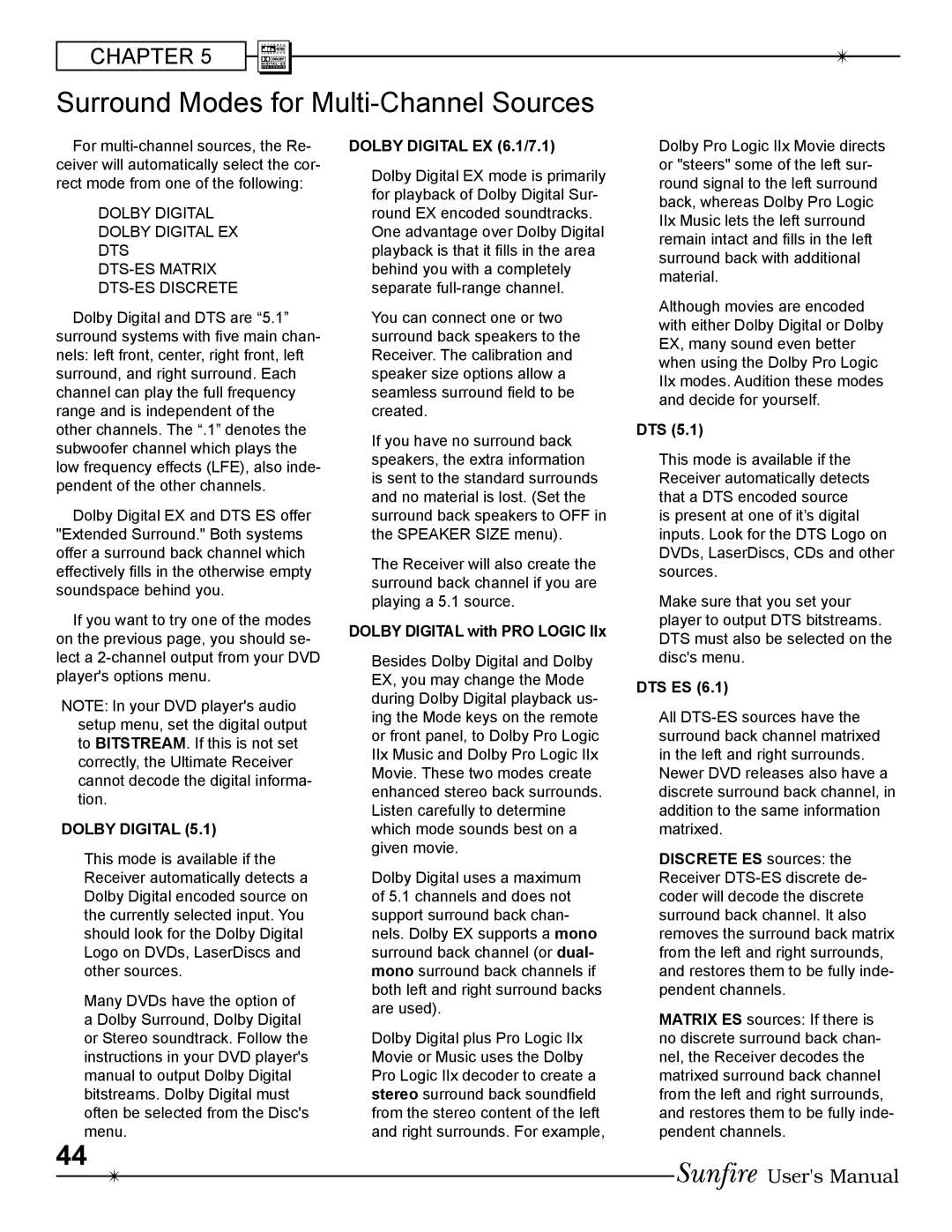
CHAPTER 5
Surround Modes for Multi-Channel Sources
For
DOLBY DIGITAL
DOLBY DIGITAL EX
DTS
Dolby Digital and DTS are “5.1” surround systems with Þve main chan- nels: left front, center, right front, left surround, and right surround. Each channel can play the full frequency range and is independent of the other channels. The “.1” denotes the subwoofer channel which plays the low frequency effects (LFE), also inde- pendent of the other channels.
Dolby Digital EX and DTS ES offer "Extended Surround." Both systems offer a surround back channel which effectively Þlls in the otherwise empty soundspace behind you.
If you want to try one of the modes on the previous page, you should se- lect a
NOTE: In your DVD player's audio setup menu, set the digital output to BITSTREAM. If this is not set correctly, the Ultimate Receiver cannot decode the digital informa- tion.
DOLBY DIGITAL (5.1)
This mode is available if the Receiver automatically detects a Dolby Digital encoded source on the currently selected input. You should look for the Dolby Digital Logo on DVDs, LaserDiscs and other sources.
Many DVDs have the option of a Dolby Surround, Dolby Digital or Stereo soundtrack. Follow the instructions in your DVD player's manual to output Dolby Digital bitstreams. Dolby Digital must often be selected from the Disc's menu.
44
DOLBY DIGITAL EX (6.1/7.1)
Dolby Digital EX mode is primarily for playback of Dolby Digital Sur- round EX encoded soundtracks.
One advantage over Dolby Digital playback is that it Þlls in the area behind you with a completely separate
You can connect one or two surround back speakers to the Receiver. The calibration and speaker size options allow a seamless surround Þeld to be created.
If you have no surround back speakers, the extra information is sent to the standard surrounds and no material is lost. (Set the surround back speakers to OFF in the SPEAKER SIZE menu).
The Receiver will also create the surround back channel if you are playing a 5.1 source.
DOLBY DIGITAL with PRO LOGIC IIx
Besides Dolby Digital and Dolby EX, you may change the Mode during Dolby Digital playback us- ing the Mode keys on the remote or front panel, to Dolby Pro Logic IIx Music and Dolby Pro Logic IIx Movie. These two modes create enhanced stereo back surrounds. Listen carefully to determine which mode sounds best on a given movie.
Dolby Digital uses a maximum of 5.1 channels and does not support surround back chan- nels. Dolby EX supports a mono surround back channel (or dual- mono surround back channels if both left and right surround backs are used).
Dolby Digital plus Pro Logic IIx Movie or Music uses the Dolby Pro Logic IIx decoder to create a stereo surround back soundÞeld from the stereo content of the left and right surrounds. For example,
Dolby Pro Logic IIx Movie directs or "steers" some of the left sur- round signal to the left surround back, whereas Dolby Pro Logic IIx Music lets the left surround remain intact and Þlls in the left surround back with additional material.
Although movies are encoded with either Dolby Digital or Dolby EX, many sound even better when using the Dolby Pro Logic IIx modes. Audition these modes and decide for yourself.
DTS (5.1)
This mode is available if the Receiver automatically detects that a DTS encoded source is present at one of it’s digital inputs. Look for the DTS Logo on DVDs, LaserDiscs, CDs and other sources.
Make sure that you set your player to output DTS bitstreams. DTS must also be selected on the disc's menu.
DTS ES (6.1)
All
DISCRETE ES sources: the Receiver
MATRIX ES sources: If there is no discrete surround back chan- nel, the Receiver decodes the matrixed surround back channel from the left and right surrounds, and restores them to be fully inde- pendent channels.
User's Manual
